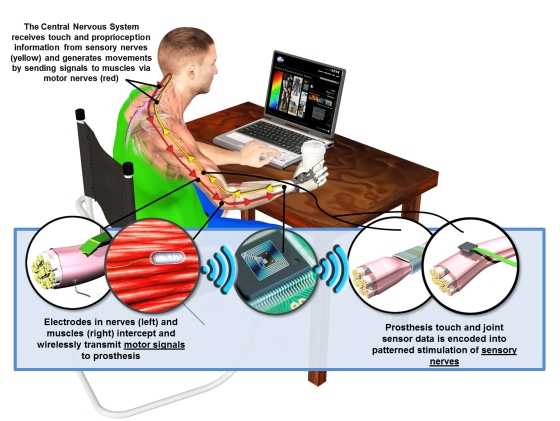This video is produced for the course Fundamentals of Technology, Communication Culture and Technology program, Georgetown University. In this video, Michael McLoughlin, the Chief Engineer of the Revolutionizing Prosthetics program of Johns Hopkins Applied Physics Laboratory, de-black-boxed the main technology of the most advanced prosthetic arm with neural feedback, and talked about its significance, concerns and the future of this technology, which turned to be a great conversation with our other interviewees, including a prosthetic designer, an IMES (implanted myoelectric senser) prosthetic arm tester and a DEKA arm tester.
DARPA’s New HAPTIX Program
DARPA has invested large amounts of money improving upper limb prosthetics. Some of the programs they funded to improve prosthetics were the Revolutionizing Prosthetics program and the DEKA Arm.
DARPA has recently started a new program called the Hand Proprioception and Touch Interfaces (HAPTIX) program. The program builds off the developments of the Revolutionizing Prosthetics program and the Reliable Neural-Interface Technology (RE-NET) program. The HAPTIX program specifically focuses on developing prosthetics with sensory feedback. According to DARPA’s website the program,
seeks to deliver those kinds of naturalistic sensations to amputees, and in the process, enable intuitive, dexterous control of advanced prosthetic devices that substitute for amputated limbs, provide the psychological benefit of improving prosthesis “embodiment,” and reduce phantom limb pain.
The Real Need – Angel Giuffria a Congenital Amputee Shares Her Experiences and Thoughts
In this interview, Angel Giuffria, a graduate Psychology student as well as a congenital amputee talked about her recent argument with her insurance company, which is caused by the neglect of amputee’s real need. Also, Angel shared lots of valuable personal views from the aspect of a real user: the revolution of wrist design, the demand for neural feedback, and the concerns of nerve surgery.
Sergeant James Sides Explains What It Is Like to Use His Prosthetic Arm
In this interview, Sgt. James Sides, a veteran who lost his right arm in an IED explosion in Afghanistan, introduced us his experience of using different prosthetic arms — from body-power, to myoelectric, and to the most advanced one with implanted myoelectric sensors (IMES).
Cost and Gain of Neural Feedback
In this interview, Chad Dize, a manager of Design Engineering of HDT Robotics, introduced the high cost of neural feedback technology in prosthetic development, and the reason why designers focus on this technology.
Dean Kamen on the DEKA Arm
De-blackboxing the Revolutionizing Prosthetic Arms
Here is part of our interview with Michael McLoughlin, the chief engineer of Research and Exploratory Development at Johns Hopkins Applied Physics Laboratory.
A Brief History of Prosthesis
The oldest known prostheses are two toes belonging to Egyptian mummies. An artificial leg dating to about 300 B.C. was unearthed in Italy, which was made of bronze and iron, with a wooden core, apparently for a below-knee amputee.
During the Middle Ages, wars were conducted using swords and other weapons that swiped and otherwise crushed limbs, which led to innovations in prosthetics, especially iron ones for knights. But outside of battle, only the wealthy were lucky enough to be fitted with a peg leg or hand hook for daily function.
In 1530s, Ambroise Pare, who is considered the father of prosthetics, introduced amputation to the medical community and made an artificial limb for the arm and elbow. In 1690s, Pieter Verduyn, a Dutch Surgeon, developed the first non-locking prosthesis for below the knee, which is the basis for the current joint and corset prosthesis.
The American Civil War caused the start of the American prosthetics field. It is reported that there were at least 30,000 amputations on the Union side alone. The Civil War marked the end of the era of wooden peg legs and simple hooks, and since then programs of the VA and the Defense Advanced Research Projects Agency (DARPA) ensured ongoing progress in prosthetics design.
Except the explosion of World War I, prosthetics were further enhanced in 1940s because of telephones and phone directories. Medical doctors were able to place illustrated ads, creating more customers.
The history of prostheses is closely related with the history of wars. And the future of prostheses is not just about helping people come back to normal life, but also protecting people from losing limbs. According to our interview with Michael McLoughlin, the Chief Engineer of Research and Exploratory Development at Johns Hopkins Applied Physics Laboratory, the development of revolutionizing prostheses will also bring us advanced robots to take place of soldiers in dangerous situation.
Resources:
Kim Norton, InMotion: A Brief History of Prosthetics
Earl Vanderwerker, A Brief Review of the History of Amputations and Prostheses
Michael MacRae, The Civil War and the Birth of the U.S Prosthetics Industry
Megan Garber, The Perfect, 3,000-Year-Old Toe: A Brief History of Prosthetic Limbs
Dudley Childress, Historical Aspects of Powered Limb Prostheses
Prosthetic Arm being developed by APL
This is an amazing arm developed by the Applied Physics Lab at John Hopkins. The project is being funded by DARPA.
The Deka Arm
The video demonstrates a veteran, who lost his arm forty years ago, using the DEKA Arm.

